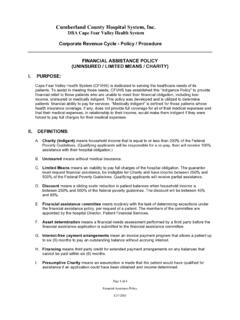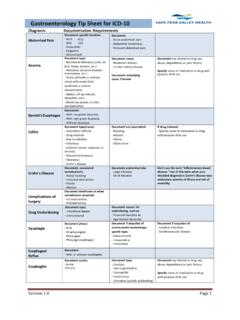Transcription of Nova Stata Strip Glucose Meter Training - Cape Fear Valley
1 nova Stat Strip Glucose Meter Training Training and Development October 2013 Waived Testing Waived testing is lab testing that has been waived by the lab for other non-laboratory personnel to perform It is also called Point of Care Testing (POCT) because it is performed at the patient s bedside or directly at the POINT of patient care rather than being sent to a lab. Waived testing differs from regular lab testing in that the specimen is not only collected, but also tested and results interpreted by non-laboratory personnel Waived Testing Physicians base their treatment and plan of care on these results, so accuracy is crucial!
2 Waived testing is both highly monitored and highly scrutinized Training and Competency Only those operators who have completed Training and have demonstrated competency may perform POCT blood Glucose testing. Initial competency Attending Training session on the Glucose Meter Successfully completing a written examination Demonstrating competence through the proper performance and interpretation of quality control Maintaining competency: Annual online education Demonstration of competence in the use of the Meter as above Blood Glucose Monitoring May be necessary for patients.
3 Who have Diabetes Mellitus who are receiving TPN or PPN who are receiving medications which affect blood Glucose concentration who have undergone liver or pancreatic procedures with post-op or post procedure elevations in Glucose secondary to stress with infection undergoing renal dialysis Quality To insure that results obtained are accurate, quality control testing (QC) using solutions with known values is performed on waived testing supplies and equipment prior to testing patient specimens. A general rule of thumb If it is a machine, QC must be performed EVERY day of patient testing.
4 If it is a supply, QC is performed when boxes or vials are first opened Quality Control (QC) Two QC samples, Level 1 (Low) and Level 3 (High) MUST be performed satisfactorily, once every 24 hrs. If this is not done, the Meter will lock out users until QC is performed All test strips and control bottles must be dated with the open date and expiration date and initials. This is a Laboratory Regulatory Requirement! :03/11/13 :06/11/13 AB QC Procedure Log-in by scanning your CFV badge Choose QC Scan the vial of test strips Press Accept Scan Control solution Level 1 Press Accept Place the test Strip into the Meter There will be a feeling of resistance as you insert the Strip QC procedure Gently mix control solution and apply drop to Strip After 6 seconds, view results (PASS/FAIL)
5 FAIL requires a comment Discard test Strip Repeat procedure with Level 3 control solution QC Procedure Troubleshooting If QC fails, the following troubleshooting steps should be taken Check your strips and QC solution expiration date Make sure the QC solution has been mixed thoroughly Repeat control test, record comment on Meter Open new set of controls and repeat test Open new test strips and repeat test QC Procedure Troubleshooting If QC continues to fail after these STOP TESTING Take the Meter out of service Contact the POCT Office for assistance Ashley Shortridge, RN Point of Care Coordinator 910-615-6145 nova Stat strips Once opened, test strips are good for 180 days (6 months minus 4 days)
6 Or manufacturer s expiration date Store at room and tightly capped as these strips are sensitive to both light and moisture Control Solutions Once opened, control solutions are good for 3 months or until expiration date on the vial Patient Testing Specimen Collection Capillary, venous, neonatal (including cord blood), and arterial whole blood specimens may be used Remember to use Standard Precautions when obtaining blood samples and performing patient testing Capillary Blood Collection (Finger stick/Heel Stick) (Important: only trained staff may use the Glucose meters . Access to the Meter is by scanning personal Trust ID badge.)
7 Use of someone else s badge may result in disciplinary action) Verify the patient s ID with 2 unique identifiers: FULL Name & DOB Remove Meter from docking station Don Gloves If an isolation room, place glucometer into clear Specimen bag Capillary Blood Collection (Finger stick/Heel Stick) Select an appropriate sampling site Palm side of the finger tip Lateral or medial plantar surface of the infant heel Warm the site if needed. Clean site with 70% alcohol and ALLOW TO AIR D R Y. Capillary Blood Collection (Finger stick/Heel Stick) Holding hand downward, massage finger with thumb toward tip to stimulate blood flow Press Login.
8 Press Scan while pointing bar code reader at ID badge barcode From the Patient Test screen press Accept Enter Strip Lot screen is displayed. Scan the Strip lot number from the side of the Strip container. Press Accept Capillary Blood Collection (Finger stick/Heel Stick) Enter the patient s ID by scanning their arm band barcode, Press Accept Insert Strip There will be a feeling of slight resistance as the Strip is inserted into the Meter Safety Lancets TWIST , do not pull the lancet needle cover off Hold the lancet against skill surface, do not press into skin Trigger the lancet by pressing on the lever-like trigger Lancets will immediately safety the needle Capillary Blood Collection Wipe off the first drop of blood, using gauze or cotton ball Allow a small drop of blood to form by gently applying intermittent pressure.
9 Do Not Milk the site. Hold the Meter in a horizontal position This will prevent blood from entering and contaminating the Meter Capillary Blood Collection Touch the end of the test Strip to the drop of blood. Capillary action will cause the blood to flow in the 4 wells on the test Strip . Capillary Blood Collection The Strip must fill completely upon touching the blood droplet If the test Strip wells do not fill completely, discard the test Strip and repeat the test with a new Strip . Do not attempt to add more blood. The Result will appear in 6 seconds Capillary Blood Collection You must ACCEPT or press OK to complete and transfer the data to the patient s record.
10 Results will not transfer to the medical record if you do not press ACCEPT or OK To accept /reject the result, press the Accept /reject soft key To add a comment before accepting or rejecting the result, press the Comment key. Accept your comment and then accept or reject the result A comment must always be added if rejecting a result Capillary Blood Collection The nurse enters the results in the patient s notes, and the appropriate action taken if any Discard the test Strip and repeat with a new Strip . Discard all contaminated patient materials in appropriate biohazard containers.








